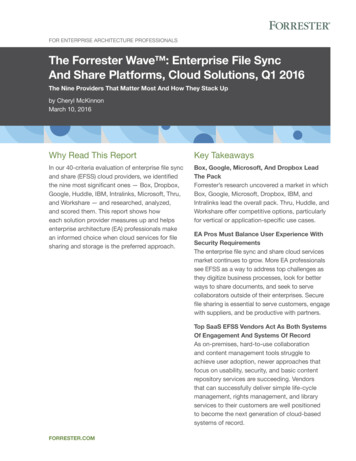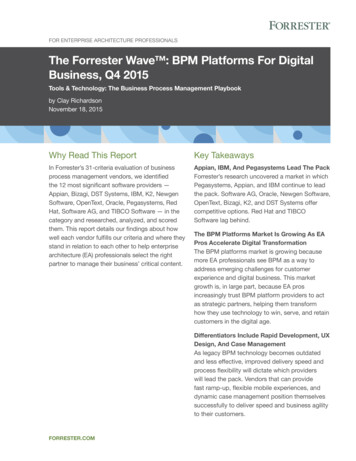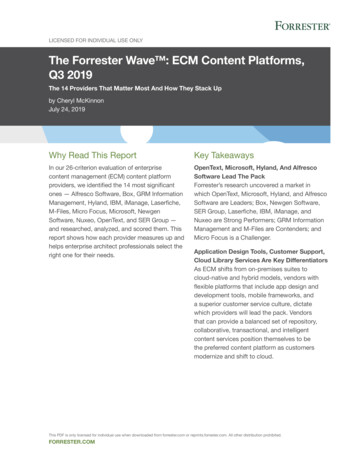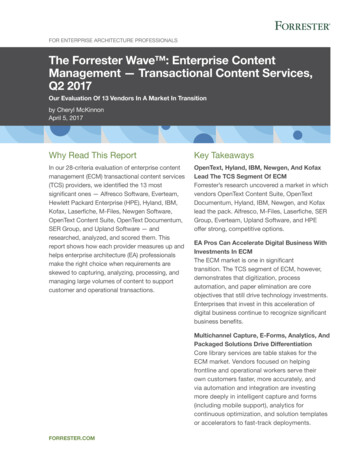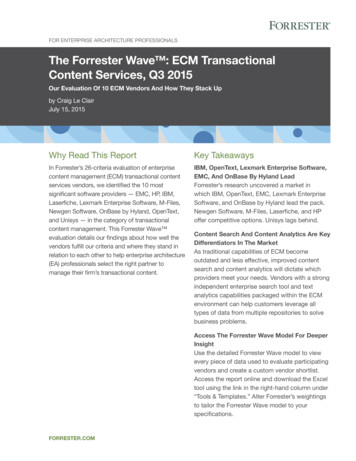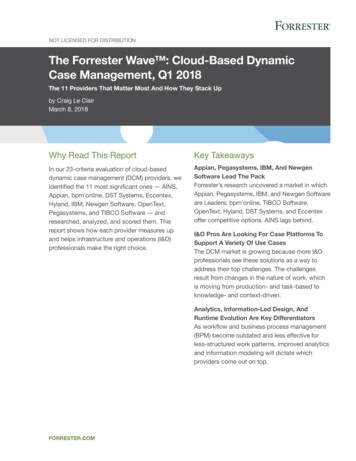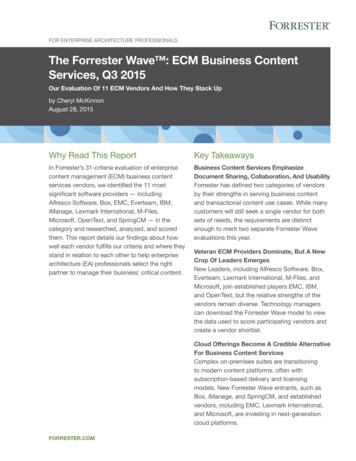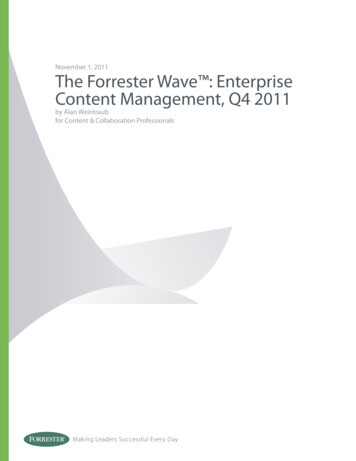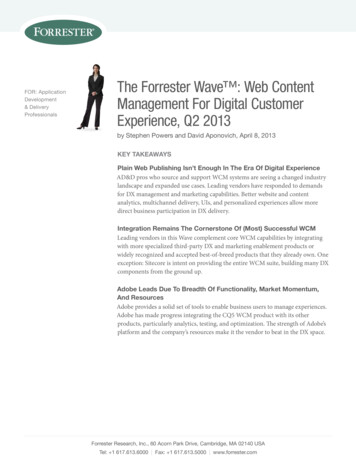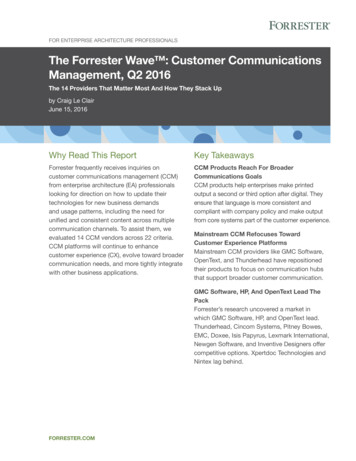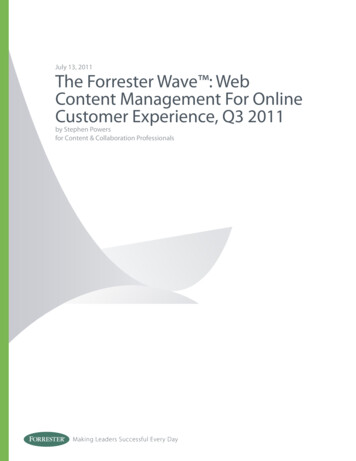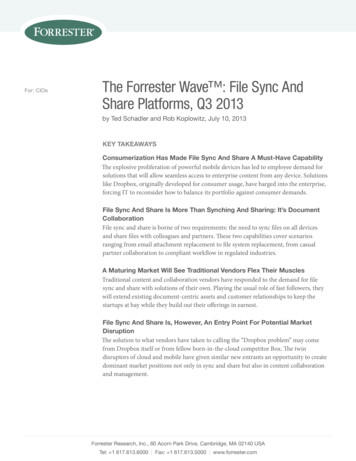
Transcription
For: CIOsThe Forrester Wave : File Sync AndShare Platforms, Q3 2013by Ted Schadler and Rob Koplowitz, July 10, 2013Key TakeawaysConsumerization Has Made File Sync And Share A Must-Have CapabilityThe explosive proliferation of powerful mobile devices has led to employee demand forsolutions that will allow seamless access to enterprise content from any device. Solutionslike Dropbox, originally developed for consumer usage, have barged into the enterprise,forcing IT to reconsider how to balance its portfolio against consumer demands.File Sync And Share Is More Than Synching And Sharing: It’s DocumentCollaborationFile sync and share is borne of two requirements: the need to sync files on all devicesand share files with colleagues and partners. These two capabilities cover scenariosranging from email attachment replacement to file system replacement, from casualpartner collaboration to compliant workflow in regulated industries.A Maturing Market Will See Traditional Vendors Flex Their MusclesTraditional content and collaboration vendors have responded to the demand for filesync and share with solutions of their own. Playing the usual role of fast followers, theywill extend existing document-centric assets and customer relationships to keep thestartups at bay while they build out their offerings in earnest.File Sync And Share Is, However, An Entry Point For Potential MarketDisruptionThe solution to what vendors have taken to calling the “Dropbox problem” may comefrom Dropbox itself or from fellow born-in-the-cloud competitor Box. The twindisruptors of cloud and mobile have given similar new entrants an opportunity to createdominant market positions not only in sync and share but also in content collaborationand management.Forrester Research, Inc., 60 Acorn Park Drive, Cambridge, MA 02140 USATel: 1 617.613.6000 Fax: 1 617.613.5000 www.forrester.com
For CIOsJuly 10, 2013The Forrester Wave : File Sync And Share Platforms, Q3 2013The 16 Providers That Matter Most And How They Stack Upby Ted Schadler and Rob Koplowitzwith TJ Keitt, Khalid Kark, and Andrew SmithWhy Read This ReportIn Forrester’s 26-criteria evaluation of file sync and share vendors, we identified, researched, analyzed,and scored products from the 16 most significant solution providers in this market: Accellion, Acronis,AirWatch, Alfresco, Box, Citrix, Dropbox, Egnyte, EMC, Google, Hightail (formerly YouSendIt), IBM,Microsoft, Novell, Salesforce.com, and WatchDox. We scored factors like mobile support, security, linksto systems of record, organizational commitment, market experience, and deployment architecture togive you the decision tools to create the right shortlist for your particular environment and scenarios. Thisreport and accompanying spreadsheet detail our findings about how well each vendor scores based on ourcriteria and where they stand in relation to each other.Table Of ContentsNotes & Resources2 File Sync And Share Is An Anchor Feature OfDocument CollaborationForrester conducted product evaluations inMarch 2013 and interviewed 30 vendor anduser companies. We evaluated solutionsfrom the following vendors: Accellion,Acronis, AirWatch, Alfresco, Box, Citrix,Dropbox, Egnyte, EMC, Google, Hightail,IBM, Microsoft, Novell, Salesforce.com, andWatchDox.2 Resolve Three Dilemmas To Make Smart FileSync And Share Choices5 Evaluation Criteria: Current Offering,Strategy, And Market Presence7 Three Vendors Earn Leader Status, But OneLeads By Half A Length11 Vendor Profiles16 Supplemental MaterialRelated Research DocumentsDocument Collaboration Vendor LandscapeMay 30, 2013 2013, Forrester Research, Inc. All rights reserved. Unauthorized reproduction is strictly prohibited. Information is based on best availableresources. Opinions reflect judgment at the time and are subject to change. Forrester , Technographics , Forrester Wave, RoleView, TechRadar,and Total Economic Impact are trademarks of Forrester Research, Inc. All other trademarks are the property of their respective companies. Topurchase reprints of this document, please email clientsupport@forrester.com. For additional information, go to www.forrester.com.
For CIOs2The Forrester Wave : File Sync And Share Platforms, Q3 2013File Sync And Share Is An Anchor Feature Of Document CollaborationEmployees have figured out that synchronizing their files across multiple devices and sharing fileswith employees and customers or partners outside the corporate firewall have collided in a singlesolution that we call (for now, anyway) file sync and share. Forrester recognizes that file sync andshare is an important foundational capability to help solve the “document collaboration” challenge.1Now IT is getting onboard and is in the hunt for business-ready solutions from vendors as diverse asAirWatch, Box, Dropbox, Egnyte, Hightail, and IBM that can address two major challenges: Keeping files synchronized across multiple personal and enterprise devices. Withconsumerization driving employees to bring personal smartphones and tablets to work,employees’ need to synchronize files grew from a whisper to a scream over the past few years.Twenty-one percent of global information workers use file sync solutions.2 The scream willgrow louder as the number of tablets will triple to 905 million by 2017 to join the billions ofcomputers and smartphones used for work.3 Sharing large files with colleagues, partners, and customers. The document collaborationscenarios continue to expand. Today, 59% of global information workers spend 15 minutesor more per day working with partners or suppliers, and another 57% spend similar amountsof time working with customers.4 Also augmenting these scenarios is the growing number ofemployees working with highly distributed teams: A third of North American and Europeaninformation workers are on teams with members in different locations.5Resolve Three Dilemmas To Make Smart File Sync And Share ChoicesYour file sync and share solution will have to accommodate an astounding breadth of documentcollaboration scenarios, each of which requires a different combination of factors. For example, youmight need to accommodate a board book or M&A process for a few dozen employees and alsoemail attachment replacement for all employees. Some scenarios might require structured workflowwhile others are more ad hoc collaborations. As if this breadth-of-scenarios problem weren’t hardenough to solve, you must also make some tough tradeoff decisions on architecture, platforms, andcost in order to pick a business-grade file sync and share solution that serves your needs now and inthe future:1. Architecture: cloud or on-premises, your storage or theirs, security or workforce experience?2. Platform: agile pure play or strategic supplier?3. Price: lower cost or higher functionality? 2013, Forrester Research, Inc. Reproduction ProhibitedJuly 10, 2013
For CIOs3The Forrester Wave : File Sync And Share Platforms, Q3 2013Architecture: Cloud Or On-Premises? Your Storage Or Theirs? Security Or Experience?Forrester believes that the technology to support document collaboration is undergoing a seismicshift from simple to complex, from desktop to mobile, and from employees to partners. Traditionalinside-the-firewall platforms handled desktops and simple teamwork. But the future platform fordocument collaboration must accommodate the complex requirements of mobile employees andpartner collaboration. File sync and share solutions are at the center of this shift because employeeshave figured out that they can solve the problem themselves with a cloud provider like Dropbox orSugarSync. Before CIOs can lead their teams to make the best product choice for the short term andfor the long term, they will have to get agreement on these architecture questions: Can you store files in and access them from the cloud? Cloud-hosted solutions are better athandling the needs of a mobile workforce and sharing documents outside the firewall. Mostcontent and most content management systems are hosted on-premises today, and many firms,particularly in regulated industries, would like to keep all documents behind the firewall. Weevaluated vendors in the Forrester file sync and share Wave with cloud, on-premises, and“hybrid” solutions. Should you store files in the vendor’s repository or your own storage system? This decisiondoesn’t matter much when we’re talking about a terabyte of storage. But when your file sync andshare scenarios encompass petabytes of storage, then storage physics and economics matter a lot.The right answer may be to host new content in the cloud yet provide sync and share access to yourcontent systems of record. The vendors in this Forrester Wave cover a full range of storage options. What’s the right tradeoff between content security and workforce experience? More securitymeans more IT controls, and controls always interfere with workforce experience. You will haveto decide where on this teeter-totter to sit: more security at the expense of user hassle, or moresimplicity at the expense of fewer controls? The decision you make may run afoul of empoweredemployees and business managers who might continue using a more convenient solution at theexpense of IT control and content compliance. We evaluate security and workforce experiencevia app store ratings in this Forrester Wave.Platform: Agile Pure Play Or Strategic Supplier?Many Forrester clients ask us if they should select a stopgap file sync and share solution and waituntil the market matures for a long-term solution. This is a tough question to answer because threemarket dynamics will play out over the next two to three years: 1) Smaller pure-play vendors willbe driven out of the market, get acquired, or specialize; 2) large traditional vendors that are behindtoday will catch up and aggressively drive down price points; and 3) one or two upstarts coulddisrupt the document collaboration market and take strong market positions. Both pure plays andstrategic suppliers have places in this early market: 2013, Forrester Research, Inc. Reproduction ProhibitedJuly 10, 2013
For CIOs4The Forrester Wave : File Sync And Share Platforms, Q3 2013 Pure-play vendors lead in functional capabilities. While the file sync and share market is youngand rapidly changing, some offerings have been out for five years or more. Not surprising, thosethat have been in the market longer have established strong early market positions. Vendors likeAcronis, Box, Egnyte, and WatchDox have mature offerings with strong security capabilities.Accellion and Hightail bundle sync with their mature external content-sharing solutions. Thesevendors contend in an increasingly competitive market with larger and sometimes better-fundedadversaries. The goal of each pure play is to stay highly innovative and build differentiatedproducts to stay relevant, or look to exploit specific vertical or horizontal business opportunities. Most of the old guard is playing catch-up. Established vendors like Google, IBM, Microsoft,Novell, and Salesforce.com have recognized the value of file sync and share as a natural add-on totheir offerings, as well as a critical mobile competency, and moved to include this capability. Notsurprisingly, they trail some of the early market entrants in terms of functionality and are playingcatch-up. For example, Citrix and EMC have fast-tracked their market positions by acquiringestablished offerings ShareFile and Syncplicity, respectively. However, their role as key vendors ofcollaboration and content capabilities that complement file sync and share and their ability toexecute in the long term make them worthy of consideration for their existing customers.Price: Lower Cost Or Higher Functionality?Cost is a key consideration for firms that need to roll out file sync and share to every employee. Yetprices and pricing models vary widely. For example, the consumer version of Dropbox is free for 5gigabytes of storage. Google bundles Drive into its 50 per user per year Google Apps portfolio with30 gigabytes of total storage. IBM and Microsoft also bundle their solutions into their cloud and onpremises products: Connections and SharePoint, respectively.Some of the pure-play vendors price their solutions at 5 per user per month; some at more like 80per user per month (albeit with advanced functionality).6 Cost is clearly a barrier to deploying file syncand share to every employee as part of the collaboration toolkit. Figuring out what the long-term costsof file sync and share really are is made more difficult as four factors drive the long-term cost equation:1. Bundled services look free, but marginal costs are hidden. Google Drive, for example, appearsto be free, but a proper assessment of value would assign a cost of something like 1 per userper month to it. And of course it’s always possible that the vendors will start pricing bundledservices separately as the market matures.2. Cloud services look simple, but expanded scenarios will add cost. Dropbox for Businessstarts at about 11 per user per month (for 100 people) with unlimited cloud storage.7 Tohandle more security, you will need to extend this baseline with a solution like nCryptedCloud for an additional cost. 2013, Forrester Research, Inc. Reproduction ProhibitedJuly 10, 2013
For CIOs5The Forrester Wave : File Sync And Share Platforms, Q3 20133. Pure plays maintain their pricing but add functionality to justify it. Where does file sync andshare leave off and a higher value workflow or content management solution kick in? The lineswill blur as vendors seek to push customers to higher value and higher cost services.4. Bring-your-own-storage solutions look cheaper but also shift cost to another budget.AirWatch, Citrix, Egnyte, and EMC are just some of the vendors that let customers use theirown storage. Bring-your-own storage lets these vendors price the file sync and share featureswithout worrying about the cost of storage. When it comes to pricing out the service for thenext five years, be sure to factor in all the costs: yours and theirs.Evaluation Criteria: Current Offering, Strategy, And Market PresenceTo assess the state of the file sync and share market and see how the vendors stack up against each other,Forrester evaluated the strengths and weaknesses of top vendors. After examining past research, userneed assessments, and vendor and expert interviews, we developed a comprehensive set of evaluationcriteria. We evaluated vendors against 26 criteria, which we grouped into three high-level buckets: Current offering. To assess product strength, we evaluated current functionality in numerousareas like device support, integration with existing prominent content technology offerings,security, deployment alternatives, and administrative capabilities. Strategy. We reviewed each vendor’s strategy, evaluating its focus on mobility, collaboration,APIs, partners, and global presence as well as how the vendor’s planned enhancements willposition it for market leadership and whether or not the vendor has the team, vision, andarchitecture to support that strategy. Market presence. To determine a vendor’s market presence, we evaluated each vendor’sinstalled base as well as its overall revenue and the number of engineers and sales staff focusedon the product.We Evaluated 16 File Sync And Share VendorsWhen selecting vendors for this evaluation in December 2012, we focused on those that hadsignificant momentum, were making strategic commitments to the market, and were most commonon enterprise shortlists. Forrester included 16 vendors in the assessment: Accellion, Acronis,AirWatch, Alfresco, Box, Citrix, Dropbox, Egnyte, EMC, Google, Hightail, IBM, Microsoft, Novell,Salesforce.com, and WatchDox. Each of these vendors has (see Figure 1): A competitive file sync and share product available in 2013. Each of the offerings evaluatedis shipping or will be available in market in 2013. These offerings handle the two primaryworkloads: managed file synchronization among multiple devices and the ability to share thatcontent with colleagues and people outside of the firm. 2013, Forrester Research, Inc. Reproduction ProhibitedJuly 10, 2013
For CIOs6The Forrester Wave : File Sync And Share Platforms, Q3 2013 The ability to serve the needs of Forrester’s enterprise clients. Each offering has the ability toserve the needs of some portion of Forrester’s enterprise users with regard to security, devicesupport, and administrative control. Not all vendors cover all requirements, but collectively theycover most of the scenarios required by Forrester’s clients. Been on a shortlist of a Forrester client. In order to keep the Forrester Wave at a manageablenumber of vendors, Forrester queried our inquiry database and solicited feedback from severalanalyst experts to help determine which vendors are most highly relevant to Forrester clients.Figure 1 Evaluated Vendors: Vendor Information And Selection CriteriaProduct versionevaluatedVersionrelease dateVendorProduct evaluatedAccellionAccellion Mobile File Sharing Solution9.3.92012AcronisactivEcho2.7.0Feb. 2013AirWatchSecure Content Locker1.5Feb. 2013AlfrescoAlfresco in the cloudNot versionedJune 2012BoxBox Enterprise EditionNot versionedN/ACitrixShareFileNot versionedN/ADropboxDropbox for BusinessNot versionedN/AEgnyteEnterprise/Office Local CloudEMCSyncplicity Business/Enterprise EditionNot versionedN/AGoogleDriveNot versionedN/AHightailHightail for EnterpriseNot versionedMarch 2012IBMIBM Connections/SmartCloud ConnectionsNot versionedN/AMicrosoftSkyDrive ProSharePoint 2013N/ANovellFilrSalesforce.com ChatterboxWatchDox8.1Feb. 1, 2013BetaApril 2013BetaN/A3.5Jan. 21, 2013Vendor selection criteriaThe vendor has or will have a competitive file sync and share product available in 2013.The vendor’s product has the ability to serve the needs of Forrester’s enterprise clients.The vendor has been on a shortlist of a Forrester client.Source: Forrester Research, Inc. 2013, Forrester Research, Inc. Reproduction ProhibitedJuly 10, 2013
For CIOs7The Forrester Wave : File Sync And Share Platforms, Q3 2013Some Vendors Were Not Included In The Detailed EvaluationDespite these selection factors, we were not able to include every vendor that could be right for yourorganization. The reason is simple: Too many vendors are vying for too few customers. We had tochoose based on the most visible and viable vendors at the time we launched the process. But thismarket is evolving so rapidly that new vendors make claims on it every day. As many as 30 or 40vendors offer file sync and share capabilities as part of their application or document collaborationor mobile management solution. While we cannot name them all, we list here some of the mostrelevant vendors that didn’t make it into the evaluation: BoardVantage. This software-as-a-service (SaaS) provider came into being more than six yearsago to address the secure document sharing that boards of directors and executive teams need.When iPad exploded on the scene, BoardVantage’s business skyrocketed. It’s now expanding itsfootprint into more horizontal scenarios to support all employees. Good Technology. Good Technology, a mobile device and application management vendor,acquired a highly secure file sync and share solution in 2012 from Copiun. Customers usingGood Technology’s device and application management solution can now also use the new filesync solution. Intralinks. This vendor began life providing virtual deal rooms — hosted collaborationworkspaces to, for example, help mergers and acquisitions teams share documents securelyamong multiple parties. It has since introduced Via, a file sync and share solution that addressesa broader array of employees and scenarios. Workshare. During the course of this evaluation, Forrester has seen an increase in demand forWorkshare’s sync and share solution among our client base. The Workshare functional valueis largely focused on sy
In Forrester’s 26-criteria evaluation of file sync and share vendors, we identified, researched, analyzed, and scored products from the 16 most significant solution providers in this market: Accellion, Acronis, AirWatch, Alfresco, Box, Citrix, Dropbox, Egnyte
